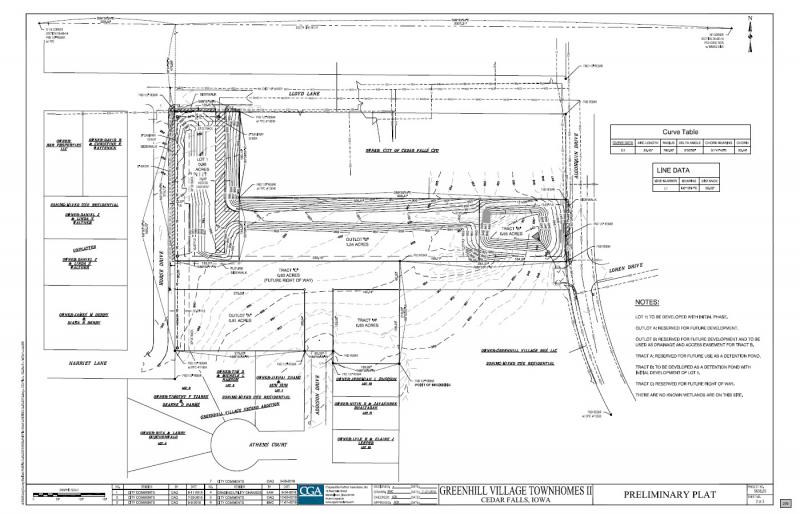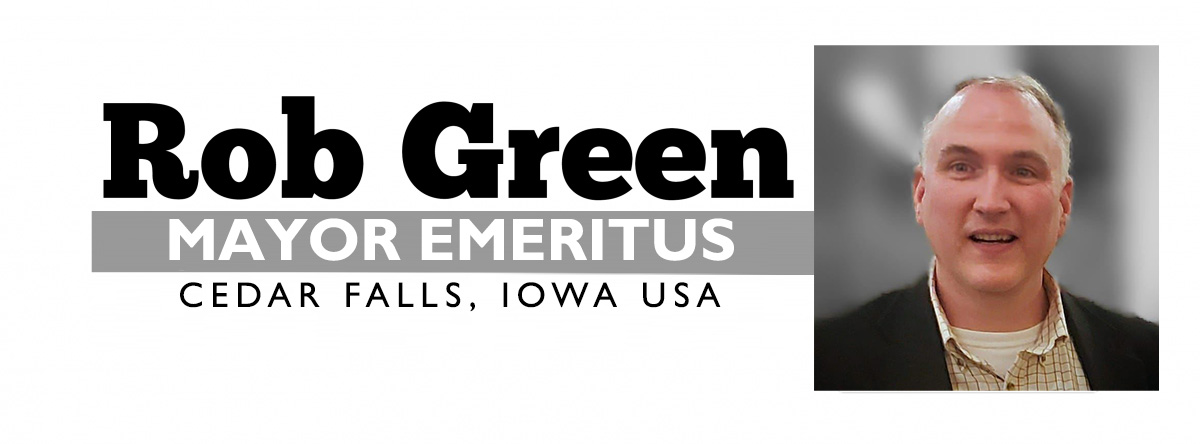
City Council recently voted to approve the preliminary plat for the "Greenhill Villiage Townhouses II" concept. For what it's worth, here's my rationale for my vote on this resolution which generated significant controversy in Greenhill Village.
What Happened (as I Understand It)
A developer desires to build townhomes on property within a neighborhood zoned as Mixed Use Residential (MU). To gain approval, several decisions have been required:
-
In April 2018, the City Council voted to change the property’s designation in the Greenhill Village Master Plan from “single-family residential” to “townhouses”. This was only after a Planning & Zoning Commission (P&Z) meeting in March 2018 to review the proposal and ensure its compliance with City Zoning Ordinances and the Cedar Falls Comprehensive Plan. No public comment was received at either the P&Z or City Council meetings regarding this change.
-
In early 2019, the Planning & Zoning Commission reviewed a preliminary plat for townhome construction on the property that had been approved for townhouses in April 2018. After receiving public input opposing the project, P&Z voted to recommend approval to City Council.
-
City Council received the preliminary plat (which is like a rough sketch of a property’s planned use) for Council approval on March 4th, 2019. This was after P&Z had considered the preliminary plat and recommended approval. In both the P&Z and council meetings, much oppositional public comment and written responses were received for consideration.
-
As some future date, P&Z and the City Council will review the Final Plat (land use doc) and then a formal Site Plan (actual building blueprints) for Greenhill Village Townhouses II project.
As a best practice (but not as a legal requirement), the City of Cedar Falls sends notifications to nearby residents when a Master Plan is being considered for a change. This notification is important, as such a change could affect property values, traffic, and the character of the neighborhood. With this notification, the public then has the opportunity to write or speak to the P&Z Commission and City Council regarding the proposed changes, and to seek to influence the final decision (i.e. due process in what appears to me to be a quasi-judicial decision).
In this case, in early 2018, the nearby residents never received notification about the proposed changes to the Master Plan from ‘single-family residential’ to ‘townhouses’. City staff states that letters were sent, but 40+ nearby residents signed an affidavit stating they had not received them. As a result, the affected residents argued that they did not have sufficient opportunity to influence the decision of the P&Z Commission or City Council in 2018.
I learned of the due process issue when reading my council packet the weekend prior to the March 4th City Council meeting. I re-watched these videos:
- Master Plan discussions from the March 28, 2018 P&Z meeting and the April 16, 2018 City Council meeting
- Preliminary Plat discussions from the January 23, 2019 P&Z meeting and the February 13, 2019 P&Z meeting.
I also carefully read the information contained in the council packet (including oppositional letters) and walked out to the property in question on Sunday, March 3, get a better sense of the area (since my usually trusty Google Earth has out-of-date overhead images). The effort allowed me to better appreciate the concerns of the residents in attendance -- concerns related not just to the specific plat design, but to the overarching issue -- the change in Master Plan designation from “single-family residential” to “townhomes”.
When Council met on March 4th, 2019, I had considered moving to ‘ table’ the Preliminary Plat (basically, to set it aside for our March 18th council meeting) and if successful, to move to change the Master Plan to “single family homes” again, and then amend THAT motion to table until the March 18th meeting as well. In my mind, a March 18th discussion about the Master Plan would have given the nearby residents the ability to express their concerns about the original Master Plan change. The City Council could then make an informed vote with the resident input in-hand. In the end, though, I decided against initiating the above parliamentary gymnastics because:
(1) State law required approval or disapproval of the preliminary plat within 60 days of submission (March 15th), making a tabling problematic in my mind;
(2) From a ‘fairness’ perspective, the developer had carried out the developmental actions in accordance with the law and council direction;
(3) In my judgment, I wasn’t likely to see or hear any additional arguments or opinions beyond what the nearby residents had already articulated quite well.
So that led into actually voting on the preliminary plat itself.
My Rationale in Voting "Yes"
Given the belief that I understood the arguments of the opposition, I voted to approve the preliminary plat based on these facts:
-
The Mixed-Use Residential (MU) zoning is intended to allow for a variety of property types. Townhouses fit in with this description and fit in with the ‘band’ of medium-density housing which is intended to separate the low-density homes from the high-density and commercial uses in the Greenhill Village Master Plan.
-
In considering the needs of the whole community, medium-density houses are allowable and desirable in the MU-zoned in this area help to distribute and diversify housing options within the city -- particularly in an “infill” area possessing existing infrastructure (and a new $1M public playground). As a result, I believe that allowing townhouses in this area is in the best interests of the people of Cedar Falls.
-
The developer's preliminary plat complied with the provisions of the city’s zoning ordinances and intent of the city’s Comprehensive Plan and future land use map.
-
An additional future opportunity exists to provide for compromise and accommodation in actual approval of the site plan for the property; approval of the preliminary plat does not necessitate approval of site plans which fail to fit in with the character of the neighborhood; I believe City Council has considerable leeway here.
Given my interest in civics and the law, I'm also wary of the dangers of arbitrary rule. Clear and well-defined ordinances allow us to be, to paraphrase John Adams, a government of laws, not of men. If a certain decision before City Council follows our code and other laws, then I believe that the City Council should only intervene to disallow it in the interests of public safety, health, or general welfare. We’re certainly not to be an automatic approving body (a.k.a. the dreaded "rubber stamp"...what would be the point of Council, then?). On the other hand, I don't believe we should vote ‘yes’ or ‘no’ on compliant projects for reasons outside of public safety, health and general welfare. The correct approach, instead, is to seek to change the law and to seek to anticipate issues before they arise.
Some Takeaways About the Vote
During both April 2018 City Council meetings, I was surprised that no one from the public had expressed opposition to the considerable change in the Master Plan. That should have been a red flag to me, but I’ll have to chalk that up as a ‘four months in’ rookie mistake. I’ll seek to do better with that, and am now collecting contact info for the city’s various homeowners associations for future outreach on similar topics. I’ve learned that “notification was sent” doesn’t necessarily mean “notification was received”. We'll need to do better as a city to engage residents on the topics which affect them.
I don’t write at length about most council decisions, but this was a tough one and worth some time for reflection and journaling. Writing helps me to think about these decisions, and I hope it's useful for you to see my thought process. Thanks for reading and for your interest in the civic life of Cedar Falls.
